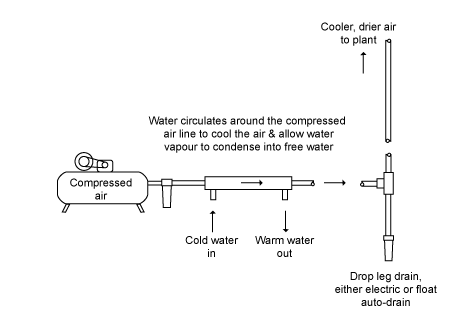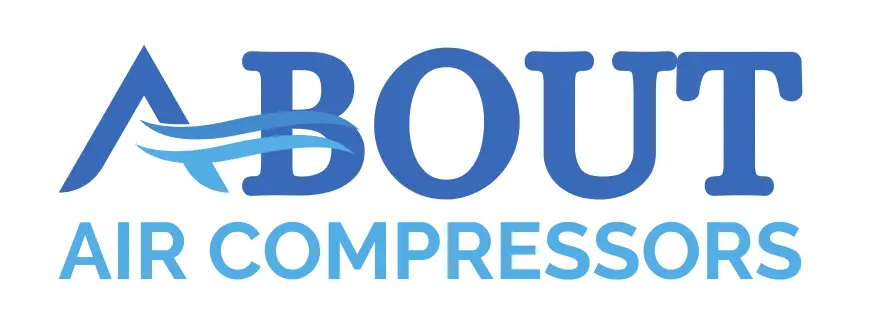One way to transfer heat from compressed air is through a device called a heat exchanger. Reducing heat in the compressed air aids in getting water vapor condensed out of the air before it gets into the plant or workshop air lines.
This page will serve as a guide to air compressor heat exchangers, presenting you with all the relevant information necessary!
Table of Contents
- What Is A Heat Exchanger?
- What Is An Air Compressor Heat Exchanger?
- Types of Heat Exchangers
- Types of compressed air system heat exchangers
- Sizing Heat Exchangers
- FAQs (Frequently Asked Questions)
What Is A Heat Exchanger?
First of all, I’ll provide you with some information of heat exchangers themselves before presenting to you air compressor heat exchangers.
An example of heat exchanging is when you put your pot on the stove element. The heat from the element is exchanged to the pot, and then from the metal of the pot to the liquid in it.
The refrigerator in your home has a heat exchanger too. It is usually located on the outside back wall of the cabinet. The heat that is being pumped out of your fridge travels through the intricate web of lines on the back of the fridge cabinet, and with the abundance of surface area of those lines, heat from within your fridge is exchanged with the cooler air surrounding the fridge.
It is a good idea to look behind the fridge periodically, and if the back is covered with dust, vacuum it off. Your fridge will work less hard, and that will cut down a bit on your energy bill.
The radiator in your car is also a heat exchanger. The hot coolant from your engine is pumped through the lines in the radiator, and as air passes through and around the fins of the radiator, heat is exchanged. The liquid within the lines of the radiator is cooled and ready to go back to your engine to pick up more heat. The coolant heat exchanges within the engine block to cool the block down.
If you wish more details on the science behind heat exchanging, I’d recommend Googling the following topics:
- “The first law of thermodynamics”
- “Fourier’s law of conduction”
- “Newton’s law of cooling”
So, how does heat exchange apply to air compressors?
What Is An Air Compressor Heat Exchanger?
Heat exchangers are everywhere and there are many different kinds that affect compressed air and air compressors. They are the brain of heat recovery systems, moving stale air through the piping systems whilst drawing in cold air from outside.
When compressed air is generated, an inevitable by-product produced is heat. In order to enhance efficiency this heat can be used to increase the efficiency of the compressed air system up to about 95%. To do this, heat exchangers are fitted to the compressed air system and within a year this investment can pay for itself.
Heat recovery technology has advanced so far today that you are able to recover over 90 percent of the heat generated by an air compressor. The heat recovery equipment may sometimes exceed your potential savings, or you may not have a way to use the recovered heat.
More realistic percentages of heat recovery are probably around 50-80% for most compressed air systems, and the amount of heat recovered depends fully on the type of compressor itself, and the type of heat exchangers you implement.
I found a helpful video that explains how this system works. Watch it!
Types of Heat Exchangers
In our case, the fluid we are primarily concerned with is the compressed air exiting our compressor receiver and heading for your air mains and air tools, air valves, air motors, air pumps and so on. Compressed air is known as fluid power, hence my saying that air is a fluid.
The other fluid is a coolant, often surrounding the compressed air line in some types of heat exchangers. Now lets talk about the two types of heat exchangers:
- Water-cooled
- Air-cooled
Water-Cooled Heat Exchangers
Water-cooled, or otherwise known as water jacket, heat exchangers work on the principle of heat exchange between two mediums, water and air. In the water jacket heat exchanger, the two fluids (compressed air and cool water) will be separated by the metal pipe of the air line. Cold water will flow around the air pipe, drawing the heat from the hot compressed air inside the pipe, and heat exchange will take place.
Below is schematic diagram on an air compressor and water-cooled heat exchanger.

The hot compressed air from the receiver is still carrying lots of water in vapor form. If the compressed air temperature is not lowered down past the dew point of the air, preferably before the air gets to the mains and the drop lines, then the compressed air will continue to de-water in the air lines.
The water vapor in the hot compressed air will continue to condense into water, creating free water in the air lines to flow down to your air tools, air valves, air motors etc. This is not good!
The heat exchanger must have a surface area large enough – or the dwell time of the two fluids in the exchanger is long enough – for sufficient heat to be transferred from the hot compressed air to the cold water.
Sizing your heat exchanger for the air consumption in your plant is very important. A too small heat exchanger will de-water the compressed air, but never enough to thoroughly cool the compressed air to allow maximum de-watering.
Air-Cooled Heat Exchangers
The majority of modern day compressed air systems also have heat exchangers that are air-cooled rather than water-cooled. These type of coolers use ambient air to cool the hot compressed air.
Typically, the compressed air will travel through either the spiral finned tube coil or a plate-fin coil design of the heat exchanger while the ambient air is forced over the cooler by a motor driven fan. The coolers ambient air removes the heat from the compressed air.
As liquid water will naturally form as the compressed air is being cooled, moisture separators and drain valves are present to remove this moisture build up.
Air-cooled compressors are one of the most common available. On average, you can recover around 72 percent of heat generated by air cooled compressors.
Types of compressed air system heat exchangers
Aftercoolers vs. Intercoolers
Aftercoolers and intercoolers are two very common heat exchangers that are used to dissipate the significant amounts of heat that air compressors generate.
An intercooler is a heat exchanger thats function is to remove heat that is generated in the air compression process. The aim for intercoolers is to restore the temperature of the compressed air to environmental levels.
An aftercooler unit operates on the principle of heat exchange between two mediums, water and air. The aftercooler unit is used to achieve temperatures between around 5-20 degrees Fahrenheit as soon as the compressed air leaves the compression unit and enters the aftercooler.
Though both function in the same manner, and are both available as water-cooled or air-cooled models depending on your requirements. They have some subtle differences in that aftercoolers operates by cooling the air emerging from the compressor system whilst an intercooler cools the air before the compressor intake.
For more information, visit our Intercooler vs Aftercooler In Compressed Air System guide!
Sizing Heat Exchangers
In order to size your heat exchanger for your air compressor, you will need to have certain information so that a heat exchange vendor or professional is able to help you determine the size you need. This includes:
- the temperature of the compressed air as it enters the heat exchanger
- the maximum flow of compressed air – you will want the exchanger to be sized to be able to heat exchange sufficiently at the maximum compressed air demand
- what temperature the compressed air should be as it leaves the heat exchanger
- how the heated water will be cooled (if purchasing a water-cooled heat exchanger)
With this information, you should be able to obtain the right sized heat exchanger for your system!
FAQs (Frequently Asked Questions)
A compressor heat exchanger is a device that cools the air within the system to it’s desired temperature. When you compress air, it’s inevitable that heat will be produced and so it is important to have the addition of an intercooler of aftercooler to reduce the temperature of the compressed air and remove excess heat so that your air tools get the quality they require.
Yes, it’s very simple physics that compressing air will generate heat. This heat energy comes from the decreasing volume of air as it is being compressed. Air temperature is directly proportional to the kinetic energy of the molecules, and as the compression begins, the molecules kinetic energy increases and so does the temperature.
If you have any questions regarding heat exchangers, please live a comment below with a photo if applicable so that someone can help you!
